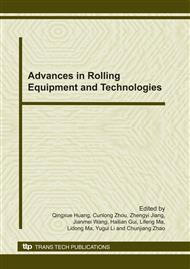[1]
Y.P. Wei, X.Y. Ruan: Transactions of Nonferrous Metals Society of China, Vol. 5 (1995) No. 3, p.66.
Google Scholar
[2]
S. Kobayashi. et.: J. of Eng. Industry, Vol. 209(1983) No. 6, p.589.
Google Scholar
[3]
Y.H. Peng: The Simulating Thchnic on Metal Plastic Forming. Shanghai: (Press of Shanghai Jiao Tong University, China 1999).
Google Scholar
[4]
N. Reble. etal.: Int.J. Mech. Sci., Vol. 31(1990) No. 11, p.985.
Google Scholar
[5]
N. Reble. etal.: Int.J. Mech. Sci., Vol. 31(1990) No. 11, p.990.
Google Scholar
[6]
C.G. Xu: Journal of Solid Mechanics, Vol. 5(1984) No. 4, p.32. (In Chinese).
Google Scholar
[7]
B.Y. Sun, H. Zhang and H. l. Sun: Transactions of Nonferrous Metals Society of China, Vol. 9(1999) No. 1, p.56.
Google Scholar
[8]
B.Y. Sun, H. Zhang et al.: Transactions of Nonferrous Metals Society of China. Vol. 5(1995) No. 5, p.23.
Google Scholar
[9]
B.Y. Sun, H. Zhang: Steel Research, Vol. 66(1995) No. 7, p.101.
Google Scholar
[10]
H. Xiao, G.X. Shen and J.C. Lian: Jour. of Mechanical Engineer-ing, Vol. 30(1990) No. 7, p.40.
Google Scholar
[11]
Q.X. Huang: Journal of Mechanical Engineering, Vol. 11(1998) No. 1, p.23.
Google Scholar
[12]
Q.X. Huang: ICME (Beijing, China, November 26-28, 2000),Vol. 1, p.258.
Google Scholar
[13]
H.M. Liu: The 3-D rolling Theory and Apply(Science Press, China 1999).
Google Scholar
[14]
H.M. Liu, J.C. Lian et al.: Journal of Material Science and Technology, Vol. 12(1996) No. 3, p.232.
Google Scholar
[15]
G.D. Wang, X.H. Liu: Artificiality Brains Optimization in Metal Rolling Process(Press of Metallurgical Industry, China 2000), (In Chinese).
Google Scholar
[16]
N. L.F. Portmann, D. Linhoff, et al.: Iron and Steel Engineer, Vol. 73(1996) No. 5, p.68.
Google Scholar
[17]
K.P. Rao and Y.K.D.V. Prasad: Journal of Materials Processing Technology, Vol. 53(1995) No. 3, p.552.
Google Scholar
[18]
J. Larkioa, P. Myllykoski et al. Journal of Materials Processing Technology, Vol. 60(1996) No. 8, p.381.
Google Scholar


